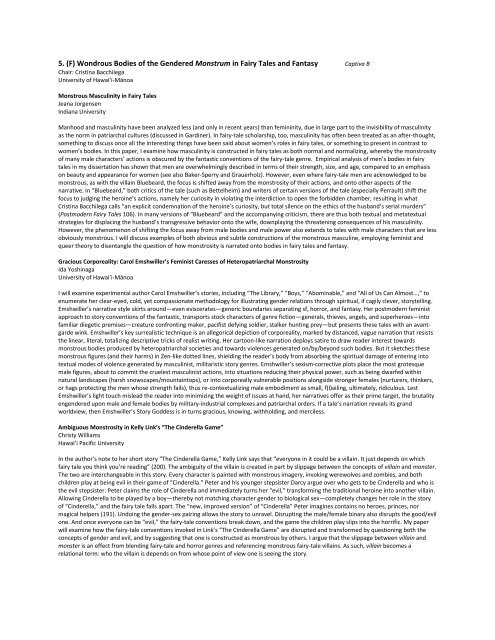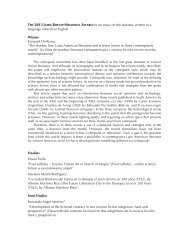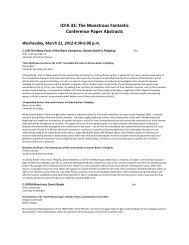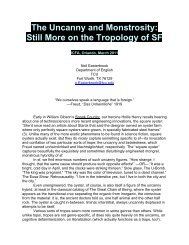The Monstrous Fantastic Conference Paper Abstracts - International ...
The Monstrous Fantastic Conference Paper Abstracts - International ...
The Monstrous Fantastic Conference Paper Abstracts - International ...
Create successful ePaper yourself
Turn your PDF publications into a flip-book with our unique Google optimized e-Paper software.
5. (F) Wondrous Bodies of the Gendered Monstrum in Fairy Tales and Fantasy Captiva BChair: Cristina BacchilegaUniversity of Hawai’i-Mānoa<strong>Monstrous</strong> Masculinity in Fairy TalesJeana JorgensenIndiana UniversityManhood and masculinity have been analyzed less (and only in recent years) than femininity, due in large part to the invisibility of masculinityas the norm in patriarchal cultures (discussed in Gardiner). In fairy-tale scholarship, too, masculinity has often been treated as an after-thought,something to discuss once all the interesting things have been said about women’s roles in fairy tales, or something to present in contrast towomen’s bodies. In this paper, I examine how masculinity is constructed in fairy tales as both normal and normalizing, whereby the monstrosityof many male characters’ actions is obscured by the fantastic conventions of the fairy-tale genre. Empirical analysis of men’s bodies in fairytales in my dissertation has shown that men are overwhelmingly described in terms of their strength, size, and age, compared to an emphasison beauty and appearance for women (see also Baker-Sperry and Grauerholz). However, even where fairy-tale men are acknowledged to bemonstrous, as with the villain Bluebeard, the focus is shifted away from the monstrosity of their actions, and onto other aspects of thenarrative. In “Bluebeard,” both critics of the tale (such as Bettelheim) and writers of certain versions of the tale (especially Perrault) shift thefocus to judging the heroine’s actions, namely her curiosity in violating the interdiction to open the forbidden chamber, resulting in whatCristina Bacchilega calls “an explicit condemnation of the heroine’s curiosity, but total silence on the ethics of the husband’s serial murders”(Postmodern Fairy Tales 106). In many versions of “Bluebeard” and the accompanying criticism, there are thus both textual and metatextualstrategies for displacing the husband’s transgressive behavior onto the wife, downplaying the threatening consequences of his masculinity.However, the phenomenon of shifting the focus away from male bodies and male power also extends to tales with male characters that are lessobviously monstrous. I will discuss examples of both obvious and subtle constructions of the monstrous masculine, employing feminist andqueer theory to disentangle the question of how monstrosity is narrated onto bodies in fairy tales and fantasy.Gracious Corporeality: Carol Emshwiller’s Feminist Caresses of Heteropatriarchal MonstrosityIda YoshinagaUniversity of Hawai’i-MānoaI will examine experimental author Carol Emshwiller’s stories, including “<strong>The</strong> Library,” “Boys,” “Abominable,” and “All of Us Can Almost…,” toenumerate her clear-eyed, cold, yet compassionate methodology for illustrating gender relations through spiritual, if cagily clever, storytelling.Emshwiller’s narrative style skirts around—even eviscerates—generic boundaries separating sf, horror, and fantasy. Her postmodern feministapproach to story conventions of the fantastic, transports stock characters of genre fiction—generals, thieves, angels, and superheroes—intofamiliar diegetic premises—creature confronting maker, pacifist defying soldier, stalker hunting prey—but presents these tales with an avantgardewink. Emshwiller’s key surrealistic technique is an allegorical depiction of corporeality, marked by distanced, vague narration that resiststhe linear, literal, totalizing descriptive tricks of realist writing. Her cartoon-like narration deploys satire to draw reader interest towardsmonstrous bodies produced by heteropatriarchal societies and towards violences generated on/by/beyond such bodies. But it sketches thesemonstrous figures (and their harms) in Zen-like dotted lines, shielding the reader’s body from absorbing the spiritual damage of entering intotextual modes of violence generated by masculinist, militaristic story genres. Emshwiller’s sexism-corrective plots place the most grotesquemale figures, about to commit the cruelest masculinist actions, into situations reducing their physical power, such as being dwarfed withinnatural landscapes (harsh snowscapes/mountaintops), or into corporeally vulnerable positions alongside stronger females (nurturers, thinkers,or hags protecting the men whose strength fails), thus re-contextualizing male embodiment as small, f(l)ailing, ultimately, ridiculous. LestEmshwiller’s light touch mislead the reader into minimizing the weight of issues at hand, her narratives offer as their prime target, the brutalityengendered upon male and female bodies by military-industrial complexes and patriarchal orders. If a tale’s narration reveals its grandworldview, then Emshwiller’s Story Goddess is in turns gracious, knowing, withholding, and merciless.Ambiguous Monstrosity in Kelly Link’s “<strong>The</strong> Cinderella Game”Christy WilliamsHawai’i Pacific UniversityIn the author’s note to her short story “<strong>The</strong> Cinderella Game,” Kelly Link says that “everyone in it could be a villain. It just depends on whichfairy tale you think you’re reading” (200). <strong>The</strong> ambiguity of the villain is created in part by slippage between the concepts of villain and monster.<strong>The</strong> two are interchangeable in this story. Every character is painted with monstrous imagery, invoking werewolves and zombies, and bothchildren play at being evil in their game of “Cinderella.” Peter and his younger stepsister Darcy argue over who gets to be Cinderella and who isthe evil stepsister. Peter claims the role of Cinderella and immediately turns her “evil,” transforming the traditional heroine into another villain.Allowing Cinderella to be played by a boy—thereby not matching character gender to biological sex—completely changes her role in the storyof “Cinderella,” and the fairy tale falls apart. <strong>The</strong> “new, improved version” of “Cinderella” Peter imagines contains no heroes, princes, normagical helpers (191). Undoing the gender-sex pairing allows the story to unravel. Disrupting the male/female binary also disrupts the good/evilone. And once everyone can be “evil,” the fairy-tale conventions break down, and the game the children play slips into the horrific. My paperwill examine how the fairy-tale conventions invoked in Link’s “<strong>The</strong> Cinderella Game” are disrupted and transformed by questioning both theconcepts of gender and evil, and by suggesting that one is constructed as monstrous by others. I argue that the slippage between villain andmonster is an effect from blending fairy-tale and horror genres and referencing monstrous fairy-tale villains. As such, villain becomes arelational term: who the villain is depends on from whose point of view one is seeing the story.





